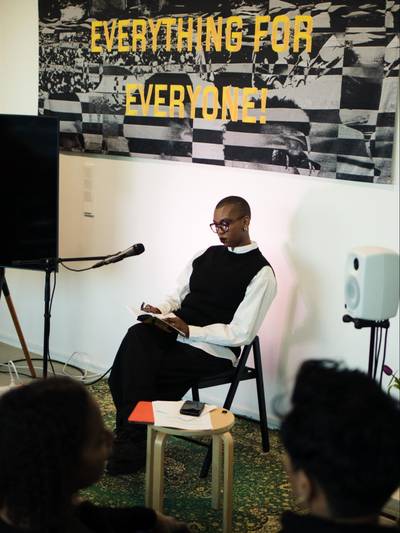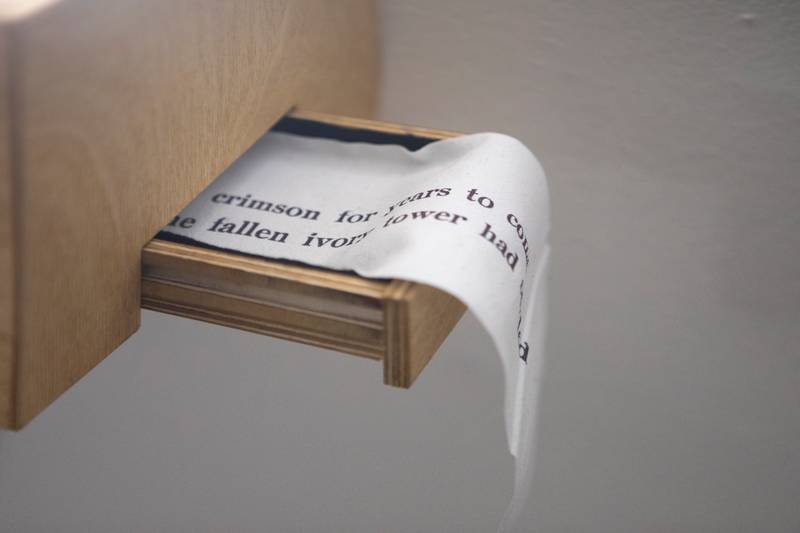

Paola Jalili (she/her) is an artist-publisher and cultural worker currently based in Helsinki. In 2021, she started Ei Mainoksia, Kiitos!, an independent art publishing initiative that aims to prioritise care and highlight the time and labour behind the act of publishing. She is part of Feminist Culture House, a curatorial and editorial platform that works with and for underrepresented artists, and produces tools for more equitable collaborations within the arts. In her visual arts practice, Paola reflects on the intersections of labour, gender, and the contemporary workplace through the project Office Aesthetics.
Shubhangi Singh is a visual artist and filmmaker. We are friends, occasional collaborators, and fellow feedback givers. In both our lives and our artistic practices many shared interests meet, ranging from gendered forms of labor and the politics of body hair, to quotidian street observations and blueberry picking. We talked about her work and her exhibition ‘Bringing a Poem to a Gunfight’, was on view at MAA-tila project space in February 2021.
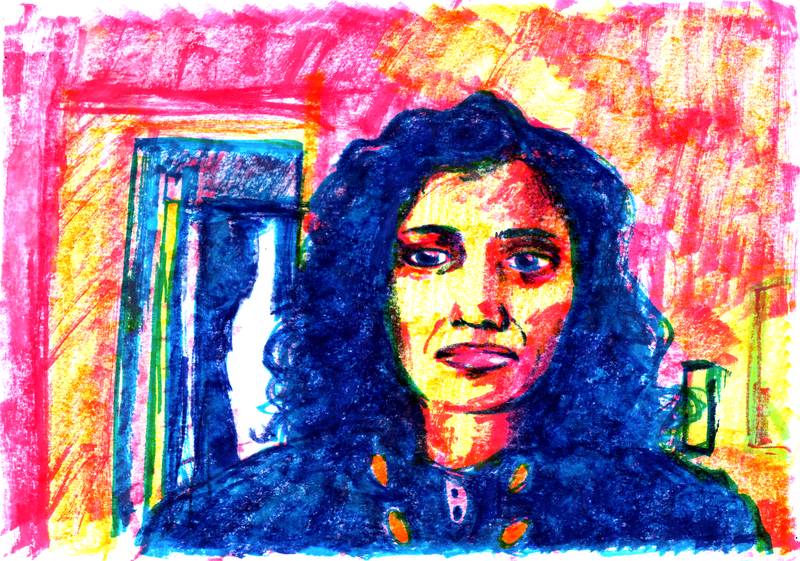

Johanna Rojola (roju), Portrait of Shubhangi Singh, 2020, felt-tip pens, markers
PAOLA: The works in Bringing a Poem to a Gunfight have been intermittently in the making for a little less than three years now, right? Did you conceive all of them as part of the same project since the beginning or did they come together only afterwards?
SHUBHANGI: The works have been in the making for a little over three years now. Let’s start with the armor. I was interested in the gloves and picking and collecting them for maybe a completely different reason, but due to the subjects that I have been interested in and researching, these objects I was collecting developed into an armor. And similarly for the dust. So I think there’s a lot of procedure to how ideas and forms meet each other, how materials and concepts are married with each other, and the making of the final form doesn’t begin, at least for me, until after these different processes have taken their course.
I am convinced that the works in this exhibition belong in the same universe, that the domesticity of the dust boxes, and the desire to protect oneself in public spaces, for instance, all belong in the same larger narrative for me. So for all of them to enter the same space was a natural act for me. Although it was never planned that way. They came together because for me they have a connection, which is visible to me, but would it be visible to somebody else if they were not laid out in the same space? By the act of putting them in the same space I feel that I am just making these already existing connections more visible.
Your practice explores domestic and public spaces in relation to the body and to labor. You just mentioned how laying out things in the same space makes certain things visible for the viewer, so perhaps you could elaborate more on the role that labor has in relation to the works, which to me might be the hardest topic to grasp immediately when visiting the exhibition.
Of course there’s the idea of invisible labor, and how easy it is for us to forget it, if not completely overlook it. And not specifically in art-making and art-viewing, but also in domesticity. Every work of mine is in fact fairly labor-intensive, but it is also absolutely soul nourishing. The dust boxes are the culmination of hours of me picking dust by hand off the top of the rug of my house, which happened for months, if not a year. That has required hours of me collecting it and then archiving it very carefully and then protecting it and, eventually, these encased boxes came along.
But this is also an opportunity to read, observe, and study dust, and to join several historical and cultural dots that this brings to the fore. For hours before I actually even began to pick it, I started by actually just thinking about dust, how we coexist with it, what we are doing to it, how we are responding to it, and how we are interacting with it. Domestic dust here is metadata that carries so much information, a record of what occurred, it has seasons and identities encased within it. When removed from its point of origin and decontextualized (or recontextualized) into a gallery setting, the dust boxes could evoke methodologies of colonial ethnography, but what happens when this methodology is adopted to reframe one’s own environment? Does it then become an object of cultural validity? A record that is of interest and value?
With the works, labor is specifically seen from the repetition and collection aspect of it, in terms of looking at something over and over again. There’s a lot of multiplicity of a singular idea. If there is a glove, there are several gloves, and by the act of there being several gloves you might suddenly begin to see the magnitude in something that could otherwise be single and invisible.
I love that idea of labor as invisible in the sense that it is also looking, thinking through, reproducing. I feel it talks a lot about you as an artist and as a person. The dust boxes are actually my favorite piece of the exhibition. And now that I’ve seen them up in the gallery with all these extra elements, they have become even more complex. I didn’t know about the drawers and the texts inside…
This is also an extension to what we were talking about earlier, how objects arrive from processes for me. And I’d like to preface this by saying that none of the works here in this show, like the brassiere pieces, the armor, the dust boxes, the video work… I really don’t think of the final form in terms of its craftsmanship necessarily—that is not my agenda. I really don’t often care about how great they appear at the end. There is something that is happening around you and it may not be possible to share it with others unless it’s made into some tangible form. If you can’t articulate it, it could be lost completely. So for me these are just articulations of ideas which I am able to offer to others.
The boxes were planned to be simply light boxes with dust on it, simulating the encased boxes and artefacts at the museums. As we were making them, over a few months, we realized that we needed the boxes to be wider than what we had first imagined. That left us with a little bit of a hollow on the side, which sparked the impulse to add a drawer to it, since it could now accommodate that. Miguel Barroso, who worked with me on the boxes, would constantly adapt and suggest, making the process into a true collaborative experience.
Well, the moment the drawers fit in, this was my chance to insert something that I had not planned for. As you approach the boxes, they offer you something that is beyond what you instantly see, but if you have the patience and the time to respond to it, you will notice these drawers. You can see the dust through a loupe, but if you have a second longer, then you can also pull the drawers, where there are these short two sentence poems that are letterpress prints on fabric. And then if you further have another second longer, then you could see the felt paper lining, which is meant to invoke these jewelry boxes we have back in India. So, it’s like a secret message you could have found in your mother’s jewelry box. All this hopefully provides a combination of sensations, including some light delights.


Domestic dust here is metadata that carries so much information, a record of what occurred, it has seasons and identities encased within it. When removed from its point of origin and decontextualized (or recontextualized) into a gallery setting, the dust boxes could evoke methodologies of colonial ethnography, but what happens when this methodology is adopted to reframe one’s own environment?
Now that you’re talking about those poems, you often include short format texts in many of your works. Can you talk about your writing process?
I use the word poetry or poem for a lack of a better term. I don’t think these are necessarily poems and I don’t quite know what they are. I would be inclined to call them epigrams but I don’t know if they fit any of the rules of epigrams. Well, I don’t know what they are at this point, so maybe somewhere someone will provide the term for this form.
But the process of writing comes from either an object or an idea that I am mulling over. The poems in the dust boxes, they all emerge from talking or thinking of either dust, my environment, or labor. The practice of gleaning, the practice of repetition, or even the mental state at the time of enacting. The line “You cannot hoist a dust flag / if you cannot tie the dust motes together” alludes to identities in flux. Of static ideas of nationhood and nationalism when much of it is just speckled and impossible to pin down. The text is vague yet offers more information to the object itself, but also in many ways, further throwing it into abstraction.
You said basically the same thing when you were talking about how you are not interested in the craftsmanship of the works, but in articulating certain ideas. So it seems this is a process present in all your works.
Yeah, I feel so. Sometimes there’s a lot of failure that happens in that process too, which is fine.
A very important part of your practice!
An essential part of my practice! If that doesn’t happen, I don’t know what I’ll be, if I don’t have acceptance of failure, that is.
Many of your works, including those in this show, are rooted in domestic spaces. Art done in home spaces and art by female artists is often labeled as “women’s art,” whereas work by male artists usually gets more specific categorizations, as you already know very well. How do you feel about this in regard to the works presented in the exhibition, and how do you negotiate with this idea in your practice in general?
The moment you work with brassieres and bodily autonomy as I am doing, I feel that I would be easily pushed into a corner, written off as someone largely working with “women’s issues,” and the moment that happens, a large chunk of the population seems to lose interest. Instead, by bringing attention to certain matters, by zooming into it and making it visible, I would hope that it is seen as a universal issue and not one that affects a small group, only further fencing them into a corner.
By the virtue of inquiring into matters that affect womxn, I feel that the brassiere works, like every other piece in this exhibition, are operating within the realm of “feminine arts,” so there is perhaps nothing I can do to remedy that but hope that this conversation is a universal one and it is seen as one.
In comparison, how many times do we have to see works purely from a male gaze involving women’s nudes and phalluses! Works that force the inner mullings, inferences, and broodings of male artists about their environment on to the world, and how large paintings of phalluses end up in museum and collections and everybody has to view them and discuss how wonderful the brush stroke is or whatever, it’s just absolutely ridiculous. So why are these subjects more important and have a greater universal acceptance than what we propose? Perhaps because no action is required from the viewers viewing these works and no one has to feel accountable for a change after. It’s easy viewing.
How do I navigate this? I feel there’s nothing to do for me but to constantly make and create more spaces. It is like drilling through existing hard shelled spaces, cemented in their ways. I think that the only way I can think about proceeding is to just bullheadedly keep going at it. There is no other option, I suppose. I doubt if I have any soft skills here, I just have methods to keep doing and hence keep being boringly repetitive in my ask for equity and focusing on what is important to me.
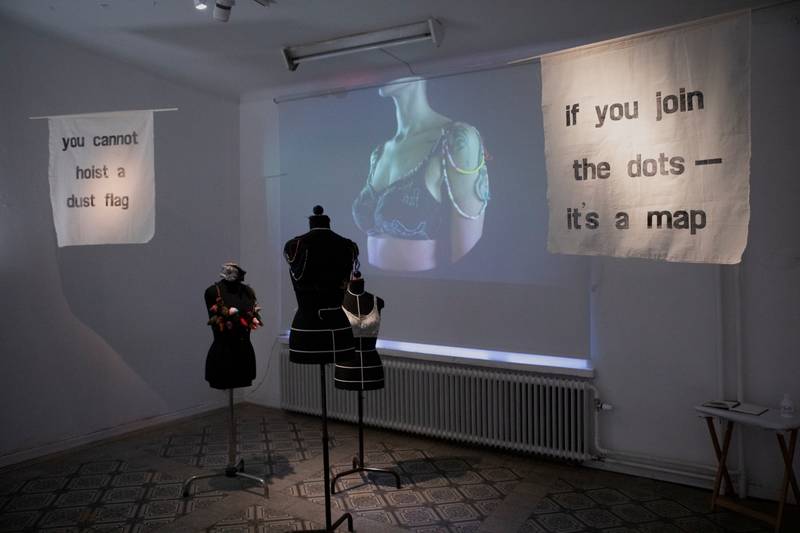

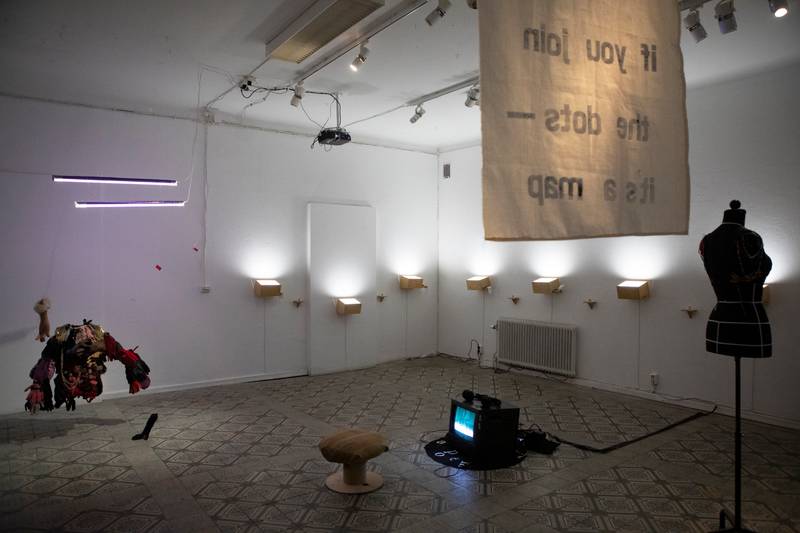

I wouldn’t call it repetitive or boring, though. For example, one thing that came to my mind when I saw all these works together was that the exhibition conjures up a sense of dreaminess and fantasy that I haven’t thought of before in relation to your work. For me, many of the works create a fantasy where that which they are denouncing doesn’t exist: the armor and the video as creations that imagine streets where violence cannot touch or hurt women’s bodies, loitering as a way of dreaming to be outside the current economy and work-based reality. Is fantasy a concept that informs your creative process, is it something that you thought about while working on this show?
I’ve never thought of my work as fantasy-based, though it could somehow be synonymous to desire-based. The fantasy is coming from desiring a certain life that you don’t have as a female in public space, perhaps. How do you create something that doesn’t exist, which is fantasy, your ideal world, an environment that is different to what it is right now? Further, an environment of safety or equity that doesn’t exist, an environment, like you said, where work is not central to one’s life, and work not being the only thing that defines an individual. Just creating a larger model that includes safety and equity but also the right to leisure.
I wasn’t thinking of fantasy per se, but definitely in terms of desires and trying to create that sort of desire through drawings, videos or even humour and through poetries. These could be some soft approaches to putting forth one’s demands. If you’re demanding your right to safety, if you’re demanding your right to leisure, are there alternate ways of demonstrating those desires? Like protesting through inaction, maybe? Those ways are also equally important. I think playfulness could also create soft ways of demanding your right to what you think is important and essential for an individual and a community. Here I am thinking of Blank Noise’s “Meet to Sleep” action, which of course works in conjunction with countless other active advocacy works done simultaneously.
So my contribution as an individual through loitering is in being more visible, being more present, being more seen.
The main point of criticism that some people have argued in relation to your work is that loitering and work refusal are actions inseparable from economic privilege. They might be thinking of Debord’s dérive or Baudelaire’s flâneur, that is, a tradition of white European men that could endlessly walk the streets of Paris thanks to their economic, gender, and non-racialized privileges. However, both your artistic research and your artworks portray a very different type of loitering and capitalist-resistant actions. Could you talk about the references that made you rethink the concepts of loitering and work refusal outside that tradition?
When speaking of loitering, the first thing that comes to mind is the 19th century Parisian flâneuring, the idea of men walking down the streets without a care in the world, you know, because they didn’t have to go and feed the kids or clean the house. But also this is mired in the conversation related to class, race, and gender, which in a lot of ways are interconnected. Who can loiter is definitely very connected to who has the resources, the capacity or the ability to do so.
This criticism around the privilege to loiter is always pertinent to me, because it feels as a chance to constantly ask myself if this is still an idea that I hold on to, and if the world still needs it right now. Otherwise, I feel as if I’m just repeating some sort of dogma that hasn’t been revisited or reworked. And through this process, some reasons are cemented while some arguments are lost.
The concept of loitering to reclaim public spaces comes from the seminal text by Shilpa Phadke, Sameera Khan, and Shilpa Ranade called Why Loiter? I think the reason why it is important is because it gave a vocabulary to what a lot of women, including myself, had been thinking about in different ways: What happens if we are more visible? By the act of being more visible, is our presence in public spaces less of an anomaly? And when it is less of an anomaly, would it mean that we are more accepted now, and hence there’s less sexual violence? I think that the writers of the text gave us some sort of a flag that said, “Here’s a flag, and you can fly it if this makes sense to you.” To which I was like, “Oh, this is how the flag looks like, of course! I’ll use this for a while.”
But again, if there is a flag, do you want to keep hoisting it every year determinedly or do you want to question the flag every now and then, or perhaps you’d want to half mast the flag at some point… All of this just means that one may need to keep asking oneself and the people who are working on the ground with these matters, to keep checking in with them.
And then there are others, like Bojana Kunst’s Artist at Work. David Graeber’s Bullshit Jobs, our favorite. “Anti-Work, Anti-Art: The Paradoxes of Radical Proximity,” by Marina Vishmidt. There’s a work by Minerva Cuevas that I really like, which is part of her project Mejor Vida Corp., where she gives student IDs to non-students so that they are able receive some sort of student benefits, something that is very minimal and won’t really create a large dent in the economy, but at the same time it helps somebody a little.


Did I ever tell you that a friend in Mexico has one of those IDs?
Yeah! It has a real world impact, which is also something that I am interested in, not just theory but also practice. Does one’s artistic work have any sort of “real world impact,” or are we just having an internal monologue within small art circuits alone, which I feel has no lure for me. There’s still a lot of chance to Minerva’s work, and I have my doubts about who is actually benefiting from it… but at the same time I think conceptually it is helpful for me to think through certain practices and how we can hack some institutional and bureaucratic systems, even if it’s only as a provocation.
This is also probably a segway into the conversation we were having of making works that are not perfect in their final form. Maybe they are just ideas in the world and somebody is allowed to take them and build upon them. Maybe if Minerva’s work is imperfect, it’s an idea that is offered to us to take and build upon it or find different forms of articulation. That way an idea can constantly keep updating itself.
Maybe here it would be relevant to mention some collectives that you have studied… I think the work that these collectives do is related to this idea of things building up on each other.
Thank you for mentioning this, I think it’s an important aspect. Definitely Blank Noise in India, Girls at Dhabas in Pakistan, Precarias a la Deriva in Spain… How do you create power through community, how do you bring access to things through mobilizing? How do you create spaces for communities that are marginalized and disenfranchised? That happens largely through groups and collectives. To be able to work in collectives is probably a way out of the tight spots that you find yourself in as minorities.
Exactly, this is where I was trying to get at, away from that European tradition I mentioned before and closer to these collectives that rethink concepts such as loitering and body autonomy from a gender, class, and race perspective. And just to go a bit deeper, how do you, as an artist, relate to these collective struggles to achieve concrete results and transformations?
In my practice, there are two ways that I am compelled to think about it. One is how I am part of communities and groups—I’m constantly trying to understand what the communities I am interested in are doing, and how I can be part of that. For example, I am inspired by the See Red Women’s Workshop, a British collective from the 1970s that provided visual tools to protests and movements. How do you also learn to take a back seat, or be a support to a movement, to somebody else’s requirements? As an artist, can you provide texts, your time, your visual aid?
Then there’s loitering and the place I currently find myself in, here in Helsinki, Finland. Gender inequity still exists here and is further perpetuated by global conditions that influence it. Here’s still a rampant wage gap, for example, as well as a lack of representation within the arts… But certain public spaces here are, in codefied ways, just out of access for other marginalized communities. How are spaces racialized? How are the conditions of not fully unlocking public spaces related to the racialized groups’ inaccessibility to shared common spaces? Or people of certain classes, say of lower income groups, how are they accessing or not accessing public spaces?
So my contribution as an individual through loitering is in being more visible, being more present, being more seen. In my practice of note-taking, I’m translating experiences into anecdotes that I document further to see how the note-taking creates a sort of record of what is happening in public spaces. It’s like a time stamp of my time and my body’s presence in specific spaces. While it may seem to take on a scientific apparatus, it is also definitely flawed, it is mired in the problematics of me looking at a society and translating what is happening or what I see without any detailed data. Though, it is equally a valid, embodied journal, a recording of my experiences and of those that I observe.
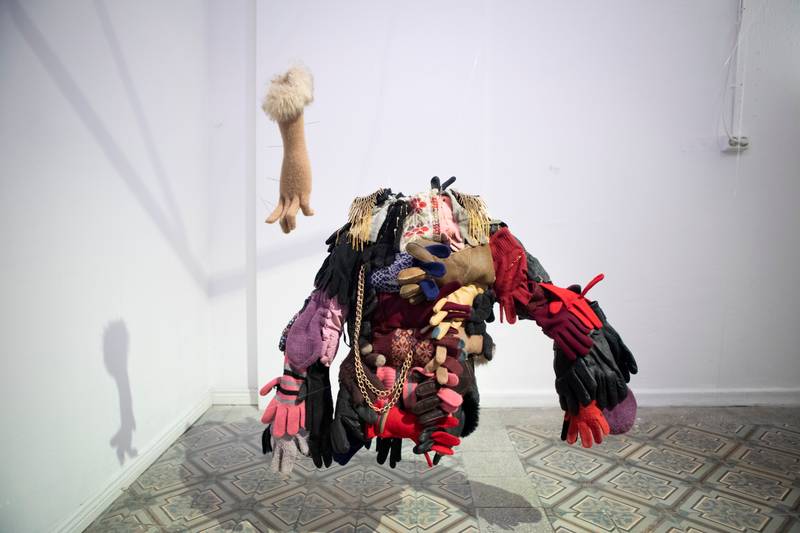

Recently, I have been reading many debates about how work is always “dignifying,” particularly in the context of covid-19 and Latin America, where some defend even the most precarious jobs behind this conception. When people insist that all work is dignifying, there’s no room for critique of better working conditions, or the need to rethink certain labor practices…
I think what I’m doing apart from discussing better working conditions—which is probably a conversation we should all constantly have—is looking at other forms of working, especially working for yourself and non-working, or un-working. There is a monolithic idea of work, which is that of working for others in exchange for money. That’s the idea I am trying to not just offset but also to attempt to break, to dismantle, as so many others around are doing. By just questioning what the fuck work even means.
Labor is happening all the time, work is happening, the process of doing, making or thinking. But how do we also do that for ourselves or for someone where the reward system is not necessarily monetary? Although is it not important to live in the world that we do? Yes, it is. Everybody has food to eat and things to pay for. But how does one demand better working conditions? What happens if you were to think of work and life as things that coexist, but do not melt into one another like streams that are completely murky, which is what often happens in the world that we live in. The more we work, somehow the better citizens of the world we supposedly are.
I think when we go to a party or meet another person, instead of asking “What do you do for a living?”, or “What do you do for work?” as one of our first questions, we could ask something different, like “What did you do for breakfast today?”, or “How did you get to this party today?” Not starting from that point, which is constantly giving importance to the act of working as an act of justifying what one does and what one doesn’t do. Otherwise, we are constantly building upon the throne that work already sits on instead of overthrowing it or creating a mutiny against this work that is sitting on this cushioned throne. Just dismantling the role of work as a monolithic massive thing. I don’t know if I answered that question…
No, actually this is a good way to close this conversation. A book that we both have enjoyed related to this balance between life and work is David Frayne’s The Refusal of Work. Personally, that book was so refreshing because it showed me different conceptions of work and ways in which work could organize our lives so that it is not as central as it is right now, such as what you were saying about how people ask what you do for a living the moment they meet you.
Exactly! I think I read that in Refusal of Work.
Now that we are talking about other forms of work in our conception of life, I’d like to bring up this joke amongst our friends about the fact that for an artist and researcher interested in loitering and work refusal, you spend a lot of time working! I suspect that beyond the humor of this, there’s the idea that when labor is performed outside a work-centered economy or outside this monolithic view of work that you mentioned, it can actually be very pleasurable, or have quite different forms and results.
Doing a lot of labor for my work is also painful! It’s not necessarily pleasure all the time. But I feel like it has more gratification for me, or imagining work as something that is your time that you give to something, but you give all of it. This exchange of giving your time for money is something that the world has organized itself around, and I aim to look at how much of it you’re giving to yourself, and how much you’re investing in yourself.
I think it’s farcical, this idea that the work we do for others is proportional to the money that we get. But it is so disproportionate, we know the amount of labor that an individual puts in every day, and what a company will get back, it’s disproportional, we know that, and yet we are led to believe it’s the only way we can organize and that there’s absolutely no way we can revolt against this ongoing practice. Strategic withdrawal is time reclaimed from the larger mechanism that stands to monetize every waking moment of ours, including our leisure time, it will still be painful, but it might be gratifying in some other sense. At no point do I make any promises of it being pleasurable one hundred percent, it’s certainly not a bed of roses all the way.
But there might still be a lot of enjoyment there! At the beginning of this conversation you said that there’s labor intensity in your practice but you also described this as soul nourishing, which I feel is so beautiful.
For sure, especially in terms of the dust boxes or the brasserie works, in the act of actually doing, there are also several other layers of work happening simultaneously. For example, while picking dust, my mind is going through a spectrum of thoughts that is pulling on this thread that has begun as perhaps an observation, but keeps growing and splintering. In the moment, a thought is like a ball of yarn, which when you let it go, goes all over the place, and yet you are still holding the end of the thread in one hand. This thread is, say, the physical act of collecting, but the ball of yarn of whys and whats has just gone all over the place and the mind is just following it, playful but also cautious. The body might be physically rooted in the act of collecting, but the end is nowhere in sight. The ball of yarn that is continuously unspooling has gone a long, long way.
That is how you can be in your head, because the focus that is created is the focus that I am defining and it is not interrupted by a need to exhibit this focus, which is what is required in the current neoliberal work environment, where one is supposed to prove their productivity, whether artistic or not. The act of having to constantly prove and exhibit one’s productivity takes away the opportunity for an idea to take flight, to be able to follow that ball of yarn to some sort of unknown, unpredicted journey, and rather cutting it short because someone is expecting a display of productivity within a brief, predefined period. It is a loss of the scope of the human imagination.
This show is occurring at a time when I wished to pause following the thread of this subject that I have been engaging with. I see it as an opportunity to open it up into a reflective environment in order to share, hear, give, and receive. The subjects in conversation have been in the working for a while now, informed by and fermenting in all sorts of active influences. Just like dust settling on something still and stationary, this show and the works within it are now open to being viewed as data, as matter to deconstruct and build upon through exchange. To gather, regroup, and then continue.
